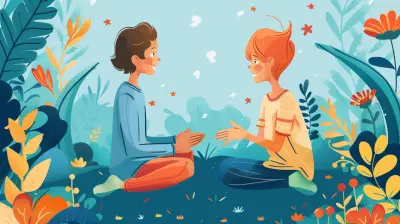Storytelling as a Communication Tool Between Parent and Child
21 June 2025
Let’s talk about bedtime stories. You know, the kind you half-make-up, half-remember from your childhood while you're desperately trying to get your toddler to stop bouncing around like a sugar-fueled kangaroo? Yeah, those. Turns out, those whimsical moments aren’t just a cute bonding ritual — they’re a powerhouse communication tool between you and your little human.
If you’ve ever wondered whether those tales of dragons, fairies, or a mischievous sock-stealing monster are actually doing anything beyond delaying bedtime, buckle up! Grab your favorite mug of something (coffee for you, milk for them), and let’s dive into the storytelling magic that unfolds when parents and kids connect through tales.
The Ancient Art of Storytelling — And Why It Still Matters
Storytelling is as old-school as it gets. Before Google, before books, before that one aunt who knows everything, there were stories. Passed down around campfires or whispered in candle-lit rooms, storytelling is humanity’s way of understanding the world and each other.Fast-forward to modern parenting, and we’ve brought storytelling into the home, often without even realizing we’re doing it. From “Once upon a time” to “When I was your age…,” these narratives build bridges between generations.
But let’s cut the fluff. This isn’t just about nostalgia — using storytelling as a communication tool builds trust, nurtures emotional intelligence, and helps your kiddo make sense of the big, confusing world around them.
Why Storytelling Works (Spoiler: It’s Basically Brain Wi-Fi)
Let’s geek out for a second. When someone listens to a story, their brain does something magical — it lights up like Times Square. Neurologically speaking, storytelling activates the parts of the brain responsible for language, sensory processing, and emotion. Even better? The listener’s brain starts to “sync” with the storyteller’s brain. It's like mental Bluetooth — only less glitchy.When you tell your child a story, especially one that involves emotions, challenges, or morals, you’re not just talking — you’re connecting on a neural level. It’s empathy on steroids.
So yeah, you might be talking about dragons, but what you’re really doing is helping your child internalize feelings, consequences, and values. Mind. Blown.
The Communication Connection
You may be wondering, “Okay, but how does storytelling help actual communication, beyond enchanting them with tales of wizards and flying tacos?”Here’s the deal:
1. Stories Open the Door to Dialogue
Ever tried asking a kid “How was your day?” and gotten a monotone “fine”? Yeah. Been there, bought the T-shirt. But start telling them a story where a little boy had a rough day because his robot friend didn’t share cookies? Suddenly, your child’s eyes widen, and — boom! — now they’re talking about how their best friend didn’t include them at recess.Storytelling creates a safe space. Kids might not have the language or confidence to say what’s bothering them directly, but through allegory and imagination, they can express themselves indirectly — and you get to read between the lines.
2. Storytelling Builds Emotional Vocabulary
Kids aren’t born knowing words like “frustrated,” “embarrassed,” or “proud.” They learn these feelings by experiencing them — and by hearing them in context.Telling stories that showcase characters facing different emotions can help your child label their feelings. Instead of acting out or shutting down, they start saying things like, “I felt mad like the dragon who couldn’t find his treasure!”
That’s a serious parenting win.
3. It Fosters Active Listening (Without the Eye Rolls)
Let’s be honest — getting kids to actually listen can feel like shouting into a wind tunnel. But stories? Oh, stories have power. When you’re telling a tale with tension, funny voices, or unexpected twists, you’ve got their full attention.And when they’re listening closely to the narrative, they’re practicing a vital communication skill: active listening. No sighs. No eye rolls. Just wide-eyed, lean-forward, mouth-slack awe. And that listening habit? It sneaks its way into regular conversations.
Neat trick, right?
How to Tap Into Storytelling as a Parent (No Publishing Deal Required)
Okay, so storytelling is great — but what if you’re not exactly Shakespeare? Or maybe you can’t remember a single fairytale that doesn’t involve someone eating poison or falling into a coma?Relax. You don’t need to be a literary genius. Here are some low-pressure, high-impact ways to make storytelling part of your parenting superpowers:
1. Use “When I Was Little” Stories
Kids are obsessed with you. Well, usually. They want to know what your life was like before you were Mom or Dad. Sharing funny, embarrassing, or tender moments from your past makes you relatable — not just the authority figure who says “no” to chocolate for breakfast.Plus, it sets the stage for them to open up too. It’s bonding and communication gold.
2. Create a Story-Telling Ritual
Whether it’s bedtime, car rides, or waiting in line at the post office, find a regular opportunity to share a short story. Make it a thing. Your child will start looking forward to these moments, and you'll be amazed at how much they share in return.3. Invite Your Child Into the Story
Make your child the hero of the story. Give them a dragon to fight, a mystery to solve, or a world to save. Let them make choices within the story. Not only does this keep them engaged, but it also teaches problem-solving and confidence.“Oh no! The jellybean monster is chasing you! Do you hide behind the cupcake waterfall or ride the marshmallow train?” Their choice. Their adventure.
4. Add a Moral — But Make It Subtle
We all want to teach life lessons, but let’s face it: preachy stories are boring. Instead, let the moral unfold naturally. Let the story do the heavy lifting.Maybe your tale about the unicorn who loved hoarding glitter ends with them learning to share — get the message across without smacking them over the head with it.
Storytelling and Growing Up: From Tantrums to Teenagers
The cool part? Storytelling evolves as your kid grows. What works at 3 will look different at 13, but the core connection remains the same.- Toddlers: Keep it simple, colorful, and repeat their favorite tales ad nauseam. They love the rhythm and predictability.
- School-Age Kids: Introduce more complex plots, characters with depth, and let them start telling you stories.
- Tweens/Teens: Use storytelling to spark real conversations. Share your own conflicts and failures. They’ll roll their eyes — but they’ll also listen.
The beauty of storytelling is that it grows with your relationship. The stories become deeper, the characters more real, and the connection — unbreakable.
Real Talk: The Benefits You Can’t Ignore
Still not convinced? Let’s roll out some parenting street cred. Regular storytelling between parent and child packs some serious perks:- 🧠 Boosts brain development and literacy
- ❤️ Strengthens emotional bonds
- 👂 Teaches listening, empathy, and focus
- 💬 Enhances communication and vocabulary
- 🚀 Sparks creativity and imagination
- 👨👩👧 Builds family culture and shared memories
All that... from a story about a talking squirrel named Mr. Nutters. Who knew?
Common Storytelling Pitfalls (And How to Dodge Them Gracefully)
Okay, nobody’s perfect. Here are a few common storytelling missteps and how to fix them:- Don’t Overthink It: You don’t have to reinvent the Wheel of Time. Even simple, silly stories are powerful when they come from you.
- Avoid Turning It into a Lecture: It’s tempting, I know. But stories aren’t sermons. Keep it subtle. Trust the narrative.
- Don’t Make It All About You: Yes, “when I was a kid…” is great — just don’t launch into a 3-hour monologue that makes their eyes glaze over. Keep it mutual.
- Watch the Scary Stuff: Especially for younger kids. Ghost clowns aren’t the vibe they’re looking for before bed. Promise.
Final Thoughts: The Stories That Stay
Years from now, your child might not remember every meal you made or how clean the living room was. But they will remember the stories. The way your voice changed for each character. The way you made them laugh when you ran out of plot and started improvising wildly. The way your tales — silly or serious — made them feel seen, understood, and deeply loved.So don’t sweat perfection. Embrace the chaos, the giggles, the tangents. Because storytelling isn't about getting the details right — it’s about using words to build bridges straight to your child’s heart.
Now go grab a blanket, snuggle up, and ask, “Wanna hear a story?”
Chances are, they’ll say yes.
all images in this post were generated using AI tools
Category:
Communication With KidsAuthor:

Kelly Snow
Discussion
rate this article
2 comments
Vincent Moore
Storytelling: the ultimate parental weapon! Not just for bedtime; it’s your secret weapon for bonding, teaching, and sneaking in life lessons. Who knew fairy tales could pack such a punch?!
November 10, 2025 at 5:01 AM

Kelly Snow
Absolutely! Storytelling is a powerful tool that fosters connection and imparts essential lessons, making it a vital part of parenting. Thank you for highlighting its impact!
Thornewood Lee
Excited to explore storytelling's magic!
June 23, 2025 at 4:35 AM

Kelly Snow
I'm glad you're excited! Storytelling truly is a powerful way to connect and communicate with our children. Enjoy the journey!


